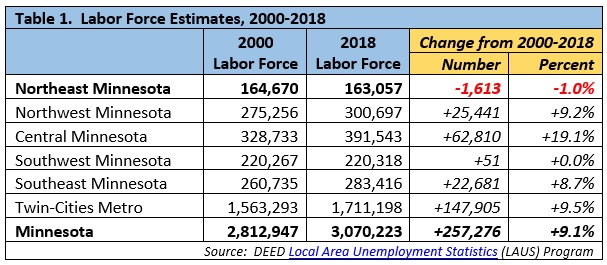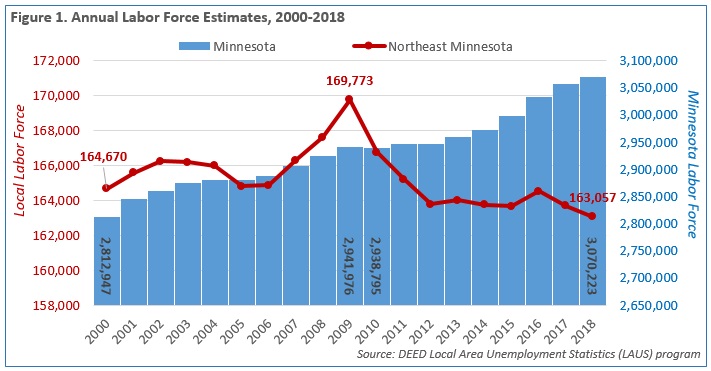 Home to the state's second-largest metro, the Northeast Region has a strong industrial sector, tied largely to the area's abundant natural resources.
Home to the state's second-largest metro, the Northeast Region has a strong industrial sector, tied largely to the area's abundant natural resources.
Most of the manufacturing base centers on mining and forest products industries. More than half of the sector's employment is in paper and machinery manufacturing.
Want the freshest data delivered by email? Subscribe to our regional newsletters.
10/17/2019 10:00:00 AM
Erik White
New Regional Profiles are now available for the Northeast planning region, Economic Development Region 3, and Workforce Development Areas 3 and 4. You will find information about demographics, labor force, income, wages, occupations, and the local economy. A major theme is the decline of the overall labor force and the impacts it will have on the region going forward.
Labor force is the number of employed people plus the number who are unemployed but looking for work. Since 2000, the labor force in Northeast Minnesota has declined by 1,613 people, a 1.0 percent decrease. In fact, Northeast is the only planning area in the state that experienced a decrease in its labor force since the start of the millennium, while the state of Minnesota has witnessed a labor force increase of 257,276 people, a 9.2 percent increase. Central Minnesota had the greatest percentage growth with a nearly 20 percent increase to its labor force, and the Twin Cities Metro had the greatest numerical growth with an increase of 147,905 people to its labor force (Table 1).

According to DEED’s Local Area Unemployment Statistics program, Northeast Minnesota had just over 163,000 workers in 2018. In 2009, in the depth of the recession, the region’s labor force reached its peak with nearly 170,000 workers but has steadily declined as the recovery from the recession has taken hold. Meanwhile, the state of Minnesota has had the opposite trend as its labor force has increased every year since 2010 and now has over 3,070,000 workers, a 4.5 percent increase (Figure 1).

Due to an aging and abating population in the region, the labor force is projected to continue to decline into the foreseeable future. Applying current labor force participation rates to future population projections by age group creates labor force projections for the region, which show a steady 5.7 percent drop in workforce numbers. In addition to the overall decline, the labor force will also see a significant shift over time, with gains in the number of workers aged 65 years and over against huge declines in the number of 45- to 64-year-old workers as the baby-boom generation proceeds into retirement age. The number of workers aged 65 years and older is expected to increase by more than 1,000 by 2030, while the number of 55- to 64-year-olds in the labor force is expected to decrease by 8,858 people. However, the region is expected to see gains in the number of 25- to 44-year-olds with an increase of 1,500 workers by 2030 (Table 2).
As Northeast Minnesota’s economy has recovered from the 2008-2009 recession, the labor market has been getting tighter as the number of unemployed has decreased to about 6,700 in 2018. And the long-term decline of the labor force will likely lead to a tight labor market in the future, with employers needing to respond to the changing labor force availability in the region. To sustain economic stability, an all-hands-on-deck approach is needed where economic disparities are reduced for people of other races and workers with disabilities, and participation rates increase for older workers.
For more information about Northeast Minnesota’s economy, check out the Regional Profiles.
Contact Erik White at 218-302-8413.